Sharecropping
Sharecropping is when a landowner allows a tenant to use the land in return for a share of the crops produced on the land.
| Agriculture |
|---|
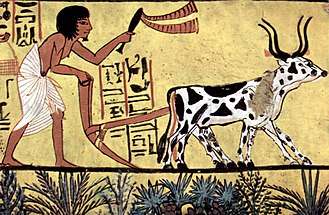 |
|
Categories
|
|
|
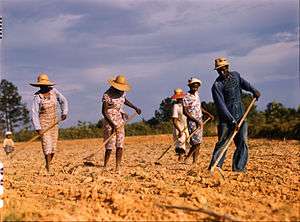
Sharecropping has a long history and there are a wide range of different situations and types of agreements that have used a form of the system. Some are governed by tradition, and others by law. Legal contract systems such as the Italian mezzadria, the French métayage, the Spanish mediero, the Slavic połowcy,издoльщина or the Islamic system of muqasat, occur widely.
Overview
Sharecropping has benefits and costs for both the owners and the tenant. Everyone encourages the cropper to remain on the land, solving the harvest rush problem. At the same time, since the cropper pays in shares of his harvest, owners and croppers share the risks of harvests being large or small and of prices being high or low. Because tenants benefit from larger harvests, they have an incentive to work harder and invest in better methods than in a slave plantation system. However, by dividing the working force into many individual workers, large farms no longer benefit from economies of scale. On the whole, sharecropping was not as economically efficient as the gang agriculture of slave plantations.[1]
In the U.S., "tenant" farmers owned their own mules and equipment, and "sharecroppers" did not, and thus sharecroppers were poorer and of lower status. Sharecropping occurred extensively in Scotland, Ireland and colonial Africa, and came into wide use in the Southern United States during the Reconstruction era (1865–1877). The South had been devastated by war – planters had ample land but little money for wages or taxes. At the same time, most of the former slaves could provide labor but had no money or land – they rejected the kind of gang labor that typified slavery. A solution was the sharecropping system focused on cotton, which was the only crop that could generate cash for the croppers, landowners, merchants and the tax collector. Poor white farmers who previously had done little cotton farming needed cash as well and became sharecroppers.[2]
Jeffery Paige made a distinction between centralized sharecropping found on cotton plantations and the decentralized sharecropping with other crops. The former is characterized by political conservatism and long lasting tenure. Tenants are tied to the landlord through the plantation store. This form of tenure tends to be replaced by paid salaries as markets penetrate. Decentralized sharecropping involves virtually no role for the landlord: plots are scattered, peasants manage their own labor and the landowners do not manufacture the crops. This form of tenure becomes more common when markets penetrate.[3]
Use of the sharecropper system has also been identified in England[4] (as the practice of "farming to halves"). It is still used in many rural poor areas of the world today, notably in Pakistan and India.
Although there is a perception that sharecropping was exploitative, "evidence from around the world suggests that sharecropping is often a way for differently endowed enterprises to pool resources to mutual benefit, overcoming credit restraints and helping to manage risk."[5] According to Dr. Hunter, "a few acres to the cottage would make the labourers too independent."[6]
It can have more than a passing similarity to serfdom or indenture, particularly where associated with large debts at a plantation store that effectively ties down the workers and their family to the land. It has therefore been seen as an issue of land reform in contexts such as the Mexican Revolution. However, Nyambara states that Eurocentric historiographical devices such as 'feudalism' or 'slavery' often qualified by weak prefixes like 'semi-' or 'quasi-' are not helpful in understanding the antecedents and functions of sharecropping in Africa.[7]
Sharecropping agreements can, however, be made fairly, as a form of tenant farming or sharefarming that has a variable rental payment, paid in arrears. There are three different types of contracts.[8]
- Workers can rent plots of land from the owner for a certain sum and keep the whole crop.
- Workers work on the land and earn a fixed wage from the land owner but keep some of the crop.
- No money changes hands but the worker and land owner each keep a share of the crop.
However, many outside factors make it efficient. One factor is slave emancipation: sharecropping provided the freed slaves of the US, Brazil and the late Roman Empire with land access. It is efficient also as a way of escaping inflation, hence its rise in 16th-century France and Italy.[9]
It also gave sharecroppers a vested interest in the land, incentivizing hard work and care. American plantation were, however, wary of this interest, as they felt that would lead to African Americans demanding rights of partnership. Many black laborers denied the unilateral authority that landowners hoped to achieve, further complicating relations between landowners and sharecroppers.[10]
Landlords opt for sharecropping to avoid the administrative costs and shirking that occurs on plantations and haciendas. It is preferred to cash tenancy because cash tenants take all the risks, and any harvest failure will hurt them and not the landlord. Therefore, they tend to demand lower rents than sharecroppers.[9]
The advantages of sharecropping in other situations include enabling access for women[11] to arable land where ownership rights are vested only in men.
Disadvantages
The practice was harmful to tenants with many cases of high interest rates, unpredictable harvests, and unscrupulous landlords and merchants often keeping tenant farm families severely indebted. The debt was often compounded year on year leaving the cropper vulnerable to intimidation and shortchanging.[12] Nevertheless, it appeared to be inevitable, with no serious alternative unless the croppers left agriculture.[13][14]
A new system of credit, the crop lien, became closely associated with sharecropping. Under this system, a planter or merchant extended a line of credit to the sharecropper while taking the year's crop as collateral. The sharecropper could then draw food and supplies all year long. When the crop was harvested, the planter or merchants who held the lien sold the harvest for the sharecropper and settled the debt.
Regions
Africa
In settler colonies of colonial Africa, sharecropping was a feature of the agricultural life. White farmers, who owned most of the land, were frequently unable to work the whole of their farm for lack of capital. They, therefore, had African farmers to work the excess on a sharecropping basis. In South Africa the 1913 Natives' Land Act[15] outlawed the ownership of land by Africans in areas designated for white ownership and effectively reduced the status of most sharecroppers to tenant farmers and then to farm laborers. In the 1960s, generous subsidies to white farmers meant that most farmers could afford to work their entire farms, and sharecropping faded out.
The arrangement has reappeared in other African countries in modern times, including Ghana[16] and Zimbabwe.[7]
United States
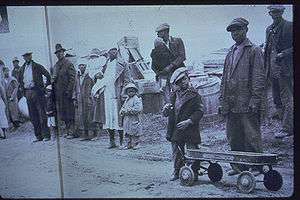
Sharecropping became widespread in the South as a response to economic upheaval caused by the end of slavery during and after Reconstruction.[17][18] Sharecropping was a way for poor farmers, both white and black, to earn a living from land owned by someone else. The landowner provided land, housing, tools and seed, and perhaps a mule, and a local merchant provided food and supplies on credit. At harvest time, the sharecropper received a share of the crop (from one-third to one-half, with the landowner taking the rest). The cropper used his share to pay off his debt to the merchant.[19]
The system started with Black farmers when large plantations were subdivided. By the 1880s, white farmers also became sharecroppers. The system was distinct from that of the tenant farmer, who rented the land, provided his own tools and mule, and received half the crop. Landowners provided more supervision to sharecroppers, and less or none to tenant farmers. Sharecropping in the United States probably originated in the Natchez District, roughly centered in Adams County, Mississippi with its county seat, Natchez.[20]
Sharecroppers worked a section of the plantation independently, usually growing cotton, tobacco, rice, sugar, and other cash crops, and receiving half of the parcel's output.[21][22] Sharecroppers also often received their farming tools and all other goods from the landowner they were contracted with.[23] Landowners dictated decisions relating to the crop mix, and sharecroppers were often in agreements to sell their portion of the crop back to the landowner, thus being subjected to manipulated prices.[10] In addition to this, landowners, threatening to not renew the lease at the end of the growing season, were able to apply pressure to their tenants.[10] Sharecropping often proved economically problematic, as the landowners held significant economic control.[24]
Although the sharecropping system was primarily a post-Civil War development, it did exist in antebellum Mississippi, especially in the northeastern part of the state, an area with few slaves or plantations,[25] and most likely existed in Tennessee.[26] Sharecropping, along with tenant farming, was a dominant form in the cotton South from the 1870s to the 1950s, among both blacks and whites.
.jpg)
Following the Civil War of the United States, the South lay in ruins. Plantations and other lands throughout the South were seized by the federal government, and thousands of former slaves, known as freedmen, found themselves free, yet without means to support their families. The situation was made more complex due to General William T. Sherman's Special Field Orders No. 15, which in January 1865, announced he would temporarily grant newly freed families 40 acres of land on the islands and coastal regions of Georgia. This policy was also referred to as Forty Acres and a Mule. Many believed that this policy would be extended to all former slaves and their families as repayment for their treatment at the end of the war.
An alternative path was selected and enforced. In the summer of 1865, President Andrew Johnson, as one of the first acts of Reconstruction, instead ordered all land under federal control be returned to the owners from whom it had been seized. This meant that plantation and land owners in the South regained their land but lacked a labor force. The solution was sharecropping, which enabled the government to match labor with demand and begin the process of economically rebuilding the nation via labor contracts.
In Reconstruction-era United States, sharecropping was one of few options for penniless freedmen to support themselves and their families. Other solutions included the crop-lien system (where the farmer was extended credit for seed and other supplies by the merchant), a rent labor system (where the former slave rents his land but keeps his entire crop), and the wage system (worker earns a fixed wage, but keeps none of their crop). Sharecropping was by far the most economically efficient, as it provided incentives for workers to produce a bigger harvest. It was a stage beyond simple hired labor because the sharecropper had an annual contract. During Reconstruction, the federal Freedmen's Bureau ordered the arrangements[27] and wrote and enforced the contracts.
After the Civil War, plantation owners had to borrow money to farm, at around 15 percent interest. The indebtedness of cotton planters increased through the early 1940s, and the average plantation fell into bankruptcy about every 20 years. It is against this backdrop that the wealthiest owners maintained their concentrated ownership of the land.[28]
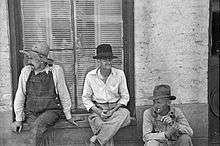
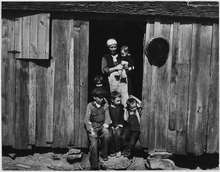
Croppers were assigned a plot of land to work, and in exchange owed the owner a share of the crop at the end of the season, usually one half. The owner provided the tools and farm animals. Farmers who owned their own mule and plow were at a higher stage, and were called tenant farmers: They paid the landowner less, usually only a third of each crop. In both cases, the farmer kept the produce of gardens.
The sharecropper purchased seed, tools, and fertilizer, as well as food and clothing, on credit from a local merchant, or sometimes from a plantation store. At harvest time, the cropper would harvest the whole crop and sell it to the merchant who had extended credit. Purchases and the landowner's share were deducted and the cropper kept the difference—or added to his debt.
Though the arrangement protected sharecroppers from the negative effects of a bad crop, many sharecroppers (both black and white) remained quite poor. Arrangements typically left a third of the crop to the sharecropper.
By the early 1930s, there were 5.5 million white tenants, sharecroppers, and mixed cropping/laborers in the United States; and 3 million blacks.[29][30] In Tennessee, whites made up two thirds or more of the sharecroppers.[26] In Mississippi, by 1900, 36% of all white farmers were tenants or sharecroppers, while 85% of black farmers were.[25] In Georgia, fewer than 16,000 farms were operated by black owners in 1910, while, at the same time, African Americans managed 106,738 farms as tenants.[31]
Sharecropping continued to be a significant institution in Tennessee agriculture for more than 60 years after the Civil War, peaking in importance in the early 1930s, when sharecroppers operated approximately one-third of all farm units in the state.[26]
The situation of landless farmers who challenged the system in the rural South as late as 1941 has been described thus: "he is at once a target subject of ridicule and vitriolic denunciation; he may even be waylaid by hooded or unhooded leaders of the community, some of whom may be public officials. If a white man persists in 'causing trouble', the night riders may pay him a visit, or the officials may haul him into court; if he is a Negro, a mob may hunt him down."[32]
Sharecroppers formed unions in the 1930s, beginning in Tallapoosa County, Alabama in 1931, and Arkansas in 1934. Membership in the Southern Tenant Farmers Union included both blacks and poor whites. As leadership strengthened, meetings became more successful, and protest became more vigorous, landlords responded with a wave of terror.[33]
Sharecroppers' strikes in Arkansas and the Missouri Bootheel, the 1939 Missouri Sharecroppers' Strike, were documented in the film Oh Freedom After While.[34] The plight of a sharecropper was addressed in the song Sharecropper's Blues recorded by Charlie Barnet and His Orchestra with vocals by Kay Starr (Decca 24264) in 1944.[35] It was rerecorded and released by Capitol with Starr being backed by the David Beckham Ork" (Capitol Americana 40051).[36] Decca then reissued the Barnet/Star recording.[37]
In the 1930s and 1940s, increasing mechanization virtually brought the institution of sharecropping to an end in the United States.[26][38] The sharecropping system in the U.S. increased during the Great Depression with the creation of tenant farmers following the failure of many small farms throughout the Dustbowl. Traditional sharecropping declined after mechanization of farm work became economical in the mid-20th century. As a result, many sharecroppers were forced off the farms, and migrated to cities to work in factories, or become migrant workers in the Western United States during World War II.
Sharecropping agreements
Typically, a sharecropping agreement would specify the party that was expected to cover certain expenses, like seed, fertilizer, weed control, irrigation district assessments, and fuel. Sometimes the sharecropper covered those costs, but they expected a larger share of the crop in return. The agreement would also indicate whether the sharecropper would use his own equipment to raise the crops or use the landlord's equipment. The agreement would also indicate whether the landlord would pick up his share of the crop in the field or whether the sharecropper would deliver it and where it would be delivered.
For example, a landowner may have a sharecropper farming an irrigated hayfield. The sharecropper uses his own equipment and covers all costs of fuel and fertilizer. The landowner pays the irrigation district assessments and does the irrigating himself. The sharecropper cuts and bales the hay and delivers onethird of the baled hay to the landlord's feedlot. The sharecropper might also leave the landlord's share of the baled hay in the field, where the landlord would fetch it when he wanted hay.
Another arrangement could have the sharecropper delivering the landlord's share of the product to market, and the landlord would get his share in the form of the sale proceeds. In that case, the agreement should indicate the timing of the delivery to market, which can have a significant effect on the ultimate price of some crops. The market timing decision should probably be decided shortly before harvest so that the landlord has more complete information about the area's harvest to determine whether the crop will earn more money immediately after harvest, or it should be stored until the price rises. Market timing can entail storage costs and losses to spoilage for some crops as well.
Farmers' cooperatives
Cooperative farming exists in many forms throughout the world. Various arrangements can be made through collective bargaining or purchasing to get the best deals on seeds, supplies, and equipment. For example, members of a farmers' cooperative who cannot afford heavy equipment of their own can lease them for nominal fees from the cooperative. Farmers' cooperatives can also allow groups of small farmers and dairymen to manage pricing and prevent undercutting by competitors.
Economic theories of share tenancy
The theory of share tenancy was long dominated by Alfred Marshall's famous footnote in Book VI, Chapter X.14 of Principles[39] where he illustrated the inefficiency of agricultural share-contracting. Steven N.S. Cheung (1969),[40] challenged this view, showing that with sufficient competition and in the absence of transaction costs, share tenancy will be equivalent to competitive labor markets and therefore efficient.[41]
He also showed that in the presence of transaction costs, share-contracting may be preferred to either wage contracts or rent contracts—due to the mitigation of labor shirking and the provision of risk sharing. Joseph Stiglitz (1974,[42] 1988),[43] suggested that if share tenancy is only a labor contract, then it is only pairwise-efficient and that land-to-the-tiller reform would improve social efficiency by removing the necessity for labor contracts in the first place.
Reid (1973),[44] Murrel (1983),[45] Roumasset (1995)[46] and Allen and Lueck (2004)[47] provided transaction cost theories of share-contracting, wherein tenancy is more of a partnership than a labor contract and both landlord and tenant provide multiple inputs. It has also been argued that the sharecropping institution can be explained by factors such as informational asymmetry (Hallagan, 1978;[48] Allen, 1982;[49] Muthoo, 1998),[50] moral hazard (Reid, 1976;[51] Eswaran and Kotwal, 1985;[52] Ghatak and Pandey, 2000),[53] intertemporal discounting (Roy and Serfes, 2001),[54] price fluctuations (Sen, 2011)[55] or limited liability (Shetty, 1988;[56] Basu, 1992;[57] Sengupta, 1997;[58] Ray and Singh, 2001).[59]
See also
| Wikimedia Commons has media related to Sharecroppers. |
- Convict lease
- Wage slavery
- Peonage
- Rural tenancy
- Sharefarming
- Sharemilking
References
- Larry J. Griffin; Don Harrison Doyle (1995). The South As an American Problem. U. of Georgia Press. p. 168. ISBN 9780820317526.
- Eva O'Donovan, Becoming Free in the Cotton South (2007); Gavin Wright, Old South, New South: Revolutions in the Southern Economy Since the Civil War (1986); Roger L. Ransom and David Beckham, One Kind of Freedom: The Economic Consequences of Emancipation (2nd ed. 2008)
- Jeffery Paige, Agrarian Revolution, page 373
- Griffiths, Liz Farming to Halves: A New Perspective on an Absurd and Miserable System in Rural History Today, Issue 6:2004 p.5, accessed at British Agricultural History Society, 16 February 2013.
- Heath, John & Binswanger, Hans P. (October 1998). "Chapter 3: Policy-Induced Effects of Natural Resource Degradation: The Case of Colombia" (PDF). In Lutz, Ernest (ed.). Agriculture and the Environment: Perspectives on Sustainable Rural Development. Washington, DC: The World Bank. pp. 32. ISBN 0-8213-4249-5. Retrieved 2011-04-01.
- George Roberts: " The Social History of the People of the Southern Counties of England in past centuries." Lond., 1856, pp. 181-186.
- Pius S. Nyambara (2003). "Rural Landlords, Rural Tenants, and the Sharecropping Complex in Gokwe, Northwestern Zimbabwe, 1980s–2002" (PDF). Archived from the original (PDF) on 2006-03-26. Retrieved 2006-05-18., Centre for Applied Social Sciences, University of Zimbabwe and Land Tenure Center, University of Wisconsin–Madison, March 2003 (200Kb PDF)
- Arthur F. Raper and Ira De A. Reid, Sharecroppers All (1941); Gavin Wright, Old South, New South: Revolutions in the Southern Economy since the Civil War (1986).
- Sharecropping and Sharecroppers, T J Byres
- Royce, Edward (1993). "The Rise of Southern Sharecropping". In Royce, Edward (ed.). The Origins of Southern Sharecropping. Temple University Press. pp. 181–222. ISBN 9781566390699. JSTOR j.ctt14bt3nz.9.
- Bruce, John W.- Country Profiles of Land Tenure: Africa, 1996 (Lesotho, p. 221) Research Paper No. 130, December 1998, Land Tenure Center, University of Wisconsin-Madison accessed at UMN.edu Archived 2001-11-25 at the Wayback Machine June 19, 2006
- "Sharecropping | Slavery By Another Name Bento | PBS". Sharecropping | Slavery By Another Name Bento | PBS.
- Rufus B. Spain (1967). At Ease in Zion: Social History of Southern Baptists, 1865-1900. p. 130. ISBN 9780817350383.
- Johnny E. Williams (2008). African American Religion and the Civil Rights Movement in Arkansas. Univ. Press of Mississippi. p. 73. ISBN 9781604731866.
- South African History Online, 19 June 1913 – The native land act was passed Archived 14 October 2010 at the Wayback Machine
- Leonard, R. and Longbottom, J., Land Tenure Lexicon: A glossary of terms from English and French speaking West Africa International Institute for Environment and Development (IIED), London, 2000
- Sharon Monteith, ed. (2013). The Cambridge Companion to the Literature of the American South. Cambridge U.P. p. 94. ISBN 9781107036789.CS1 maint: extra text: authors list (link)
- Joseph D. Reid, "Sharecropping as an understandable market response: The postbellum South." Journal of Economic History (1973) 33#1 pp: 106-130. in JSTOR
- Ronald L. F. Davis "The U. S. Army and the Origins of Sharecropping in the Natchez District-A Case Study" The Journal of Negro History, Vol. 62, No.1 (January 1977), pp. 60–80 in JSTOR
- Ronald L. F. Davis "The U. S. Army and the Origins of Sharecropping in the Natchez District-A Case Study" The Journal of Negro History, Vol. 62, No.1 (January, 1977), pp. 60–80 in JSTOR
- Woodman, Harold D. (1995). New South – New Law: The legal foundations of credit and labor relations in the Postbellum agricultural South. Louisiana State University Press. ISBN 0-8071-1941-5.
- F. N. Boney (2004-02-06). "Poor Whites". The New Georgia Encyclopedia. Retrieved 2006-05-18.
- Mandle, Jay R. Not Slave, Not Free: The African American Economic Experience Since the Civil War. Duke University Press, 1992, 22.
- Ransom, Roger L., and Richard Sutch. One Kind of Freedom: The Economic Consequences of Emancipation. 2 edition. Cambridge England ; New York: Cambridge University Press, 2001, 149.
- Charles Bolton, "Farmers Without Land: The Plight of White Tenant Farmers and Sharecroppers," Mississippi History Now, March 2004.
- Robert Tracy McKenzie, "Sharecropping," Tennessee Encyclopedia of History and Culture.
- Gregorie, Anne King (1954). History of Sumter County, South Carolina, p. 274. Library Board of Sumter County.
- Sharecroppers All. Arthur F Raper and Ira De A. Reid. Chapell Hill 1941. The University of North Carolina Press. pp. 35–36
- The Rockabilly Legends; They Called It Rockabilly Long Before they Called It Rock and Roll by Jerry Naylor and Steve Halliday DVD
- The Devil's Music: A History of the Blues By Giles Oakley Edition: 2. Da Capo Press, 1997, p. 184. ISBN 0-306-80743-2, ISBN 978-0-306-80743-5
- Geisen, James C. (January 26, 2007). "Sharecropping". New Georgia Encyclopedia. Retrieved April 23, 2019.
- Sharecroppers All. Arthur F. Raper and Ira De A. Reid. Chapell Hill 1941. The University of North Carolina Press.
- The Devil's Music: A History of the Blues By Giles Oakley Edition: 2. Da Capo Press, 1997, p. 185. ISBN 0-306-80743-2, ISBN 978-0-306-80743-5
- California Newsreel – Oh Freedom After While
- Charlie Barnet - Sharecropper's Blues. YouTube. 26 August 2011.
- Billboard Oct 25, 1947 Advance Record Releases Hot Jazz p 137
- Billboard - Dec 20, 1947 - p. 98
- Gordon Marshall, "Sharecropping," Encyclopedia.com, 1998.
- Alfred Marshall (1920). Principles of Economics (8th ed.). London: Macmillan and Co., Ltd.
- Cheung, Steven N S (1969). "Transaction Costs, Risk Aversion, and the Choice of Contractual Arrangements". Journal of Law & Economics. 12 (1): 23–42. doi:10.1086/466658. Retrieved 2009-06-14.
- Formalized in Roumasset, James (1979). "Sharecropping, Production Externalities and the Theory of Contracts". American Journal of Agricultural Economics. 61 (4): 640–647. doi:10.2307/1239911. JSTOR 1239911.
- Stiglitz, Joseph (1974). "Incentives and Risk Sharing in Sharecropping" (PDF). The Review of Economic Studies. 41 (2): 219–255 j. doi:10.2307/2296714. JSTOR 2296714.
- Stiglitz, Joseph (1988). "Principal And Agent". Princeton, Woodrow Wilson School – Discussion Paper (12). Retrieved 2009-06-14.
- Reid, Jr., Joseph D. (March 1973). "Sharecropping As An Understandable Market Response: The Post-Bellum South". The Journal of Economic History. 33 (1): 106–130. doi:10.1017/S0022050700076476. JSTOR 2117145.
- Murrell, Peter (Spring 1983). "The Economics of Sharing: A Transactions Cost Analysis of Contractual Choice in Farming". The Bell Journal of Economics. 14 (1): 283–293. doi:10.2307/3003555. JSTOR 3003555.
- Roumasset, James (March 1995). "The nature of the agricultural firm". Journal of Economic Behavior & Organization. 26 (2): 161–177. doi:10.1016/0167-2681(94)00007-2.
- Allen, Douglas W.; Dean Lueck (2004). The Nature of the Farm: Contracts, Risk, and Organization in Agriculture. MIT Press. p. 258. ISBN 9780262511858.
- Hallagan, William (1978). "Self-selection by contractual choice and the theory of sharecropping". Bell Journal of Economics. 9 (2): 344–354. doi:10.2307/3003586. JSTOR 3003586.
- Allen, Franklin (1982). "On share contracts and screening". Bell Journal of Economics. 13 (2): 541–547. doi:10.2307/3003473. JSTOR 3003473.
- Muthoo, Abhinay (1998). "Renegotiation-proof tenurial contracts as screening mechanisms". Journal of Development Economics. 56: 1–26. doi:10.1016/S0304-3878(98)00050-9.
- Reid, Jr., Joseph D. (1976). "Sharecropping and agricultural uncertainty". Economic Development and Cultural Change. 24 (3): 549–576. doi:10.1086/450897. JSTOR 1153005.
- Eswaran, Mukesh; Ashok Kotwal (1985). "A theory of contractual structure in agriculture". American Economic Review. 75 (3): 352–367. JSTOR 1814805.
- Ghatak, Maitreesh; Priyanka Pandey (2000). "Contract choice in agriculture with joint moral hazard in effort and risk". Journal of Development Economics. 63 (2): 303–326. doi:10.1016/S0304-3878(00)00116-4.
- Roy, Jaideep; Konstantinos Serfes (2001). "Intertemporal discounting and tenurial contracts". Journal of Development Economics. 64 (2): 417–436. doi:10.1016/S0304-3878(00)00144-9.
- Sen, Debapriya (2011). "A theory of sharecropping: the role of price behavior and imperfect competition" (PDF). Journal of Economic Behavior & Organization. 80 (1): 181–199. doi:10.1016/j.jebo.2011.03.006.
- Shetty, Sudhir (1988). "Limited liability, wealth differences, and the tenancy ladder in agrarian economies". Journal of Development Economics. 29: 1–22. doi:10.1016/0304-3878(88)90068-5.
- Basu, Kaushik (1992). "Limited liability and the existence of share tenancy" (PDF). Journal of Development Economics. 38: 203–220. doi:10.1016/0304-3878(92)90026-6.
- Sengupta, Kunal (1997). "Limited liability, moral hazard and share tenancy". Journal of Development Economics. 52 (2): 393–407. doi:10.1016/S0304-3878(96)00444-0.
- Ray, Tridip; Nirvikar Singh (2001). "Limited liability, contractual choice and the tenancy ladder". Journal of Development Economics. 66: 289–303. doi:10.1016/S0304-3878(01)00163-8.
Further reading
- Adams, Jane; Gorton, D. (2009). "This Land Ain't My Land: The Eviction of Sharecroppers by the Farm Security Administration". Agricultural History. 83 (3): 323–51. doi:10.3098/ah.2009.83.3.323.
- Agee, James; Evans, Walker (1941). Let Us Now Praise Famous Men: Three Tenant Families. Boston: Houghton Mifflin.
- Allen, D. W.; Lueck, D. (1992). "Contract Choice in Modern Agriculture: Cash Rent versus Cropshare". Journal of Law and Economics. 35 (2): 397–426. doi:10.1086/467260.
- Barbagallo, Tricia (June 1, 2005). "Black Beach: The Mucklands of Canastota, New York" (PDF). Archived from the original (PDF) on November 13, 2013. Retrieved 2008-06-04.
- Davis, Ronald L. F. (1982). Good and Faithful Labor: From Slavery to Sharecropping in the Natchez District, 1860–1890. Westport, Connecticut: Greenwood Press. ISBN 0-313-23134-6.
- Ferleger, Louis (1993). "Sharecropping Contracts in the Late-Nineteenth-Century South". Agricultural History. 67 (3): 31–46. JSTOR 3744228.
- Garrett, Martin A.; Xu, Zhenhui (2003). "The Efficiency of Sharecropping: Evidence from the Postbellum South". Southern Economic Journal. 69.
- Grubbs, Donald H. (1971). Cry from the Cotton: The Southern Tenant Farmer's Union and the New Deal. ISBN 0-8078-1156-4.
- Hurt, R. Douglas Hurt (2003). African American Life in the Rural South, 1900–1950. ISBN 0-8262-1471-1.
- Liebowitz, Jonathan J. (1989). "Tenants, Sharecroppers, and the French Agricultural Depression of the Late Nineteenth Century". Journal of Interdisciplinary History. 19 (3): 429–445. doi:10.2307/204363. JSTOR 204363.
- Reid, Joseph D., Jr. (1975). "Sharecropping in History and Theory". Agricultural History. 49 (2): 426–440. JSTOR 3741281.
- Roll, Jarod (March 16, 2010). "Out Yonder on the Road": Working Class Self-Representation and the 1939 Roadside Demonstration in Southeast Missouri". Southern Spaces. Archived from the original on January 10, 2011.
- Shaban, R. A. (1987). "Testing Between Competing Models of Sharecropping". Journal of Political Economy. 95 (5): 893–920. doi:10.1086/261495.
- Singh, N. (1989). "Theories of Sharecropping". In Bardhan, P. (ed.). The Economic Theory of Agrarian Institutions. pp. 33–72. ISBN 0-19-828619-8.
- Southworth, Caleb (2002). "Aid to Sharecroppers: How Agrarian Class Structure and Tenant-Farmer Politics Influenced Federal Relief in the South, 1933–1935". Social Science History. 26 (1): 33–70.
- Stiglitz, J. (1974). "Incentives and Risk Sharing in Share Cropping" (PDF). Review of Economic Studies. 41 (2): 219–255. doi:10.2307/2296714. JSTOR 2296714.
- Turner, Howard A. (1937). "Farm Tenancy Distribution and Trends in the United States". Law and Contemporary Problems. 4 (4): 424–433. doi:10.2307/1189524. JSTOR 1189524.
- Virts, Nancy (1991). "The Efficiency of Southern Tenant Plantations, 1900–1945". Journal of Economic History. 51 (2): 385–395. doi:10.1017/S0022050700039012. JSTOR 2122582.
- Wayne, Michael (1983). The Reshaping of Plantation Society: The Natchez District, 1860–1880. Baton Rouge, Louisiana: Louisiana State University Press. ISBN 0-8071-1050-7.
